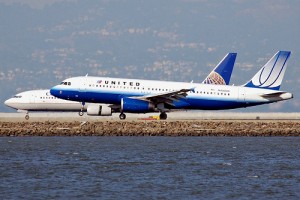
A United Airlines A320-200 lands while a Continental Boeing 737 is in the background.
Back home! It is a good feeling. One downside is I have a week’s worth of stories to catch up on, since I had limited internet access. I figured I would share some of the more interesting stories I found with you, in case you missed them too!
* Aeromexico is cutting flights after the new Arizona immigration reform, via BlueTales.
* United Airlines celebrates 80 years of having flight attendants, via Seattle PI.
* Airlines collected $7.8billion in fees last year. Yes, that is billion and yes, they will not be going away anytime soon, via Today in the Sky.
* The Boeing 787 Dreamliner lands at San Antonio for additional testing, via Randy’s Journal.
* United Airlines and Continental Airlines decide to merge, via Things in the Sky.
* Comparison how the new UAL/CO merger stacks up to its competition, via Airline Biz Blog.
* UAL/CO merger compared to TWA merger, via AviationWeek.
* Continental CEO apologizes for calling US Airways the ,”ugly girl,” via Today in the Sky.
* Monitor what your kids are watching, while flying, via Runway Girl.
* Video re-creation of the Turkish Airlines crash in Amsterdam last year, via Flight Global.
Anything else interesting happen that I might have missed?
Image: Rich Snyder
connect | web | twitter | facebook |
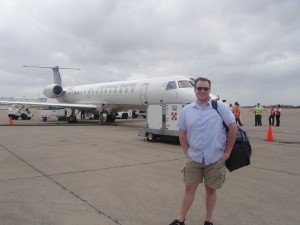
Me in front of the first ERJ-145 I flew after landing at Mazatlan Airport. I love being able to get close to the plane on the tarmac.
I am currently about 37,000 feet on a Continental Express ERJ-145. I am heading from Mazatlan, Mexico (MZT) to Houston, TX (IAH), then on to my home in Seattle (SEA) [which will be on a Boeing 757]. Well, sort of…right now, as I write this blog, it is the morning of Saturday May 8th. My flight does not have wi-fi, but I am writing it in notepad and will post it up on Monday the 10th. Every time I am in the air, I always try to write up at least a few blogs, since I love the inspiration.
This is my second flight in a regional jet, my first being a week ago heading from IAH to MZT. It is quite amazing, with all my flying experience I have not flown on a ERJ-145. My home base is in Seattle and there just aren’t many flights with regional jets to and from SEA.
When booking my flight, I purposely choose Continental since I would be able to fly on an ERJ-145 (I know, I have heard the “airline nerd” jokes already). I have heard some positive, but mostly negative things about flying the aircraft and I was excited to check it out myself.
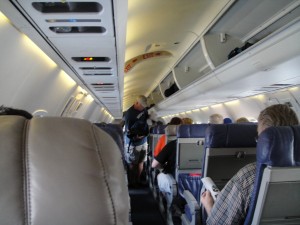
The 1-2 layout is nice, but small overhead-bins are only on one side.
There are a lot of people out there that do not like flying in smaller planes. They will go out of their way and pay more to avoid them. Yes, the ride can be more bumpy, there are normally less experienced pilots flying them, and it can be a tight fit. However, I think the positives out weigh the negatives.
For me, the smaller the aircraft let me feel more connected to the flying experience. I understand that some people like to forget they are in a man-made machine 37,000 feet above the ground, but not me.
I enjoy the 1-2 seat layout. There is a single seat on the left side of the plane and two seats on the right side of the plane. This means that every person either has a window or aisle seat. On both flights I sat on the single seat side. It is nice being able to see out the window and have easy access to the aisle.
The seats feel quite roomy and the ERJ-145 has 17.3″ width and 31″ pitch, which isn’t bad. The Boeing 737-800 I flew from SEA to IAH also had 31″ pitch and only 17.2″ width.
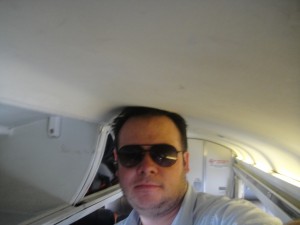
Don't make fun of my hecka-awesome shades or my man-beard. Headroom wasn't so great for being 6'1".
The ERJ-145 only holds 50 passengers, which gives it an intimate experience. I seems easier to talk to other passengers and get to know those around me. Since there are less passengers, the turn around time of the aircraft is very short (time from landing to being able to take off again). This allows airlines to provide more flight options to destinations and more flights to smaller airports.
There are a few downsides to the ERJ-145. I am currently sitting in row 17 of 19 rows. The only lavatory is located at the back of the aircraft. It seems not many people went to the restroom before taking off, since a lot of folks have made a visit back here. I could see where this would be distracting for someone wanting to sleep.
There is also very limited carry-on room. If you are trying to bring on bigger carry-ons, be prepared to have them checked. Out of the five of us travelling in my group, only two were able to bring their carry-ons aboard (and we were able to take all of them on board the Boeing 737 from SEA to IAH).
I have heard people talk about service on smaller regional aircraft can be sub-par. Even though I have experienced great service on some smaller airlines, like Horizon Air (the free beer or wine helps), I have personally seen a lower level of service when flying regional aircraft. Although I did get a free snack (this will be short lived), the flight attendants, both to and from MZT, definitely were not friendly and were quite rude to passengers. It could have just been a coincidence, but it was noticeable.
My flights to and from MZT were Continental Express, which is run by ExpressJet, however, the Continental name is on the airplane and on my ticket. I strongly feel that is a larger airline is willing to put their name on a regional airline, they are partly responsible for the quality of service one receives. Passengers should have a consistent level of service no matter what kind of aircraft they are flying.
The ERJ-145 is built by Embraer, an airplane manufacture based out of Brazil. The aircraft first flew in August 1995 and started service with airlines in 1996. To date over 1,100 ERJ’s have been manufactured. With so many ERJ-145’s out there and many more on order, I have a feeling this won’t be my last experience with this aircraft type.
Find a few more pics via my Flickr account.
connect | web | twitter | facebook |
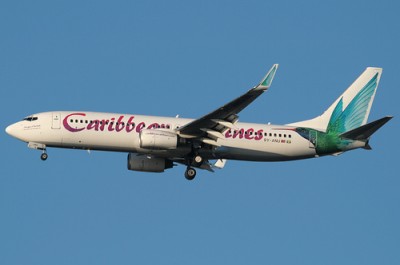
My mom love's hummingbirds and this livery delivers!
A very special Mother’s Day to my mom and all the mom’s out there. My mom has been wonderfully supportive of my blog (even writing a few blogs herself)!
THANKS MOM!
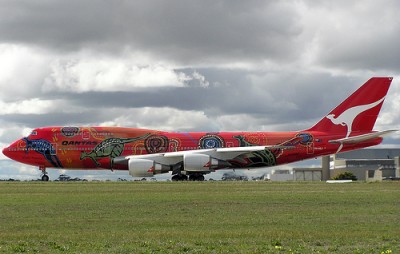
"Wunala Dreaming" is the name of this Qantas 747-400, painted with a design inspired by Aboriginal art.
Each week I do an airline livery and many times I have been given a heads up by Yvette Scott (@airlinesangel) on new liveries to take a look at. I am about to return from my vacation and have asked her to do the livery of the week today. Here is her post:
I’m very honoured that David had asked me to select the livery of the week. Each week I look forward to which airline/livery David has discovered, many are new, many are from the past, but they all have a story to tell in the great world of aviation.
The airline I’ve selected is Qantas, Australia’s largest airline and the considered to be the world’s oldest continually operating airline. Their fleet consists of over 251 aircraft, ranging from Bombardier Dash 8 to Airbus A380.
Today their livery is white fusalage with a red tail featuring the distinctive kangaroo logo. Their B747-438, in addition to their usual city names, carry the word “Longreach” as part of the livery. This signifies both the “long reach” of the aircraft and the town where Qantas began. In 1993, as part of the International Year of the World’s Indigenous People, some aircraft were named and painted aircraft with Aboriginal themes.
More photos through Airliners.net
Thanks Yvette! Be sure to also check out her blog: Airlines Angel.
Blog Image: Denmac25

The Doggie that rode next to Dani
I was reading a friend’s personal blog recently and came across a blog she wrote last December. I thought it really brings up some interesting points and wanted to share it. Here is Dani Dutro’s story in her own words:
It’s 5:30am and my alarm goes off. Less than 2 minutes later I get a phone call. The shuttle is calling to let me know that they’re early (and acting like I should give them a prize for being early before 6am!! Not cool. I hug my aunt goodbye and hop in the shuttle. We go to pick up other passengers and at one stop, I can see that the driver missed his turn on purpose because a police officer had just made the same turn in front of us and apparently I’m dealing with some kind of felon as a driver because he doesn’t want to be anywhere near an officer ’“ greeeeaaaat.
Finally, we arrive safely at LAX. I’m already checked in and sail through the TSA line. This officer actually flirts with me and this is the only time I have ever gone through airport security and remained in a good mood.
Now I have time for coffee and a little reflection upon my awesome trip to the Evolution of Psychotherapy Conference’¦
And then we begin the boarding process’¦
As I’m walking down the ramp I notice this woman in an argument with the gate agent. The woman has about 6 carryon bags (including a guitar in a hard case and a black dog on a leash wearing a service animal jacket). The woman is upset because the agent is telling her they may not be able to get her guitar into the first class closet and it may need to be checked. I was thinking to myself that both women should calm down ’“ the one with all the carryon should have been at the gate earlier and the agent should really just learn to be NICE!
I sit down and stow all my luggage (a modest duffel and my backpack/bookbag) and then I notice that the woman with the carryon & the dog are definitely going to sit with me. She’s bumping into literally everyone as she goes down the aisle with her carryon, dog, and not small self (only 9 rows back) and now I’m a little annoyed. She is calling a lot of attention to herself and her dog is clearly a poorly-trained ’œemotional support animal’ and I’m starting to feel a little of the gate agent’s pain on this one. Finally she sits down and the dog squeezes into the floor space between us.
Moments later a man walks to the edge of our aisle and is visibly annoyed because he sees my seatmate literally spilling into his seat and then he notices the dog where his feet are supposed to be. The woman is not exactly accommodating to him or the flight attendants and made a comment about how it was the flight attendant’s job to fix the situation and she was not particularly interested in taking up her ’œfair’ share of the seat. The gentleman moved on quite quickly and the flight attendant apparently did reseat him.
The woman settles in, and before the door is closed she hits me with, ’œI’m sorry I’m such a pain but I’m heading to my father’s funeral.’ Who’s the asshole now, D’½
So, we talked, she cried, I did some good while on the plane’¦ Taught me a lot about how to take a minute and have empathy wherever I am. It was a great lesson especially since I had just spent 4 amazing days at a conference renewing my passion for counseling ’“ how fitting that a woman in need of some brief grief counseling would end up sitting next to me on the plane (with her sweet doggie)!
connect | web | twitter | facebook |






